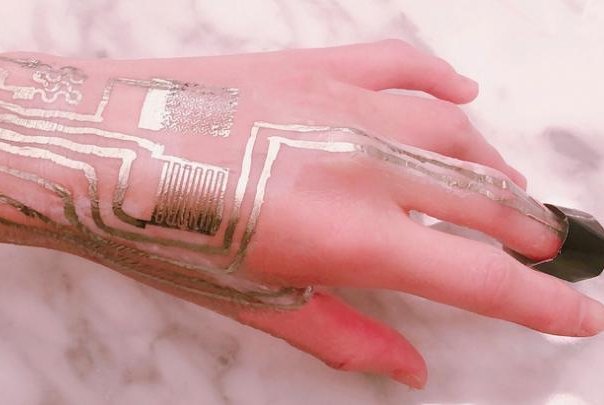Wearable tattoo: Scientists print sensors directly onto skin without heat
Wearable tattoo: Scientists print sensors directly onto skin withou...

Oct. 12 (UPI) -- Engineers have developed a way to print biometric sensors onto skin, like a non-permanent tattoo, without the use of heat.
In addition to being more comfortable and less intrusive than today's wearable devices, the technology -- described Monday in the journal ACS Applied Materials and Interfaces -- can also collect more precise biometric measurements.
"In this article, we report a simple yet universally applicable fabrication technique with the use of a novel sintering aid layer to enable direct printing for on-body sensors," first author Ling Zhang, researcher in the Harbin Institute of Technology in China, said in a news release.
Zhang and lead researcher Huanyu "Larry" Cheng, professor of engineering science and mechanics at Penn State University, previously fabricated flexible printed circuit boards for wearable devices.
Because the sintering process, the bonding of metallic components to the sensor, required temperatures of 572 degrees Fahrenheit, the fabrication wasn't suitable for human skin.
"The skin surface cannot withstand such a high temperature, obviously," Cheng said. "To get around this limitation, we proposed a sintering aid layer -- something that would not hurt the skin and could help the material sinter together at a lower temperature."
Researchers were first able to lower the sintering temperature to 212 degrees Fahrenheit by adding a new nanoparticle to the silver components -- creating what scientists called a sintering aid layer.
"That can be used to print sensors on clothing and paper, which is useful, but it's still higher than we can stand at skin temperature," Cheng said. "We changed the formula of the aid layer, changed the printing material and found that we could sinter at room temperature."
Researchers made their new aid layer out of polyvinyl alcohol paste and calcium carbonate. The layer allowed scientists to fuse the ultra-thin layer of metal patterns to the sensor using a hair dyer set on cool. The resulting device is flexible and boasts all the necessary electromechanical characteristics.
In tests, scientists used their new wearable sensor to measure temperature, humidity, blood oxygen levels and heart rhythms.
While the wearable sensor can survive hand washing, scientists suggests a hot shower would cause it to wash away.
"It could be recycled, since removal doesn't damage the device," Cheng said. "And, importantly, removal doesn't damage the skin, either. That's especially important for people with sensitive skin, like the elderly and babies. The device can be useful without being an extra burden to the person using it or to the environment."
In a followup study, scientists plan to print sensors designed to track symptoms and vital signs associated with COVID-19.
"Destroying the New World Order"
THANK YOU FOR SUPPORTING THE SITE!
Latest Activity
- Top News
- ·
- Everything
entitlement
Death Threats for Assisting ICE?
'They’re Waiting for Us to Die': Area 51 Veterans Plead for Trump’s Help | Elizabeth Vargas Reports
I joined Facebook after 5 years of suspension!!! It went as expected.
Who Were the Silver Ghosts and Fork Tailed Devils Over Germany in WWII?
THE GREAT FLOOD Official Trailer (2026) Netflix | Global Disaster Movies 4K
Mothman Prophecies
The 100 Series Designated for SAC and a Possible WWIII
© 2025 Created by truth.
Powered by
![]()
You need to be a member of 12160 Social Network to add comments!
Join 12160 Social Network